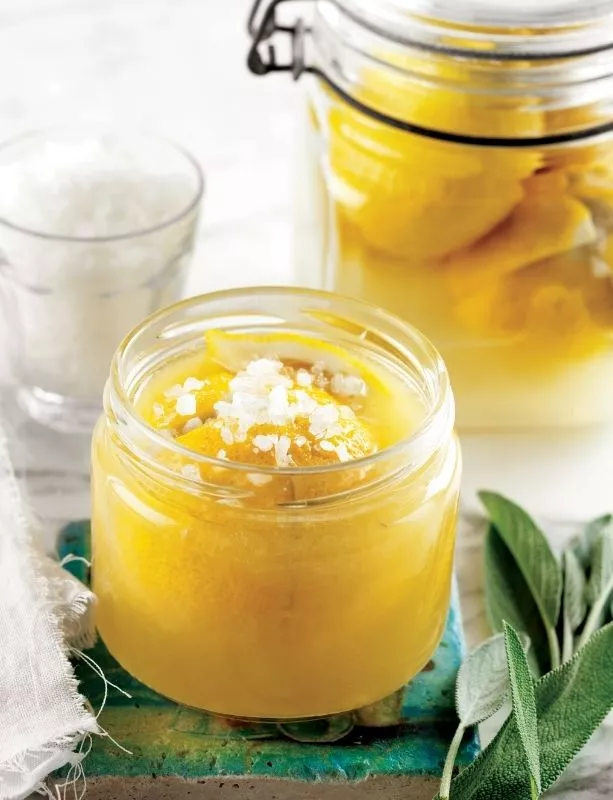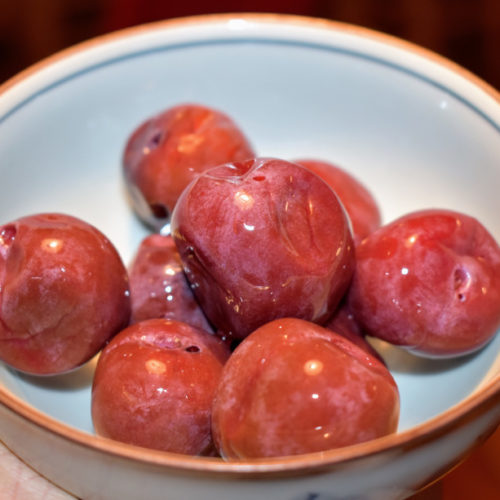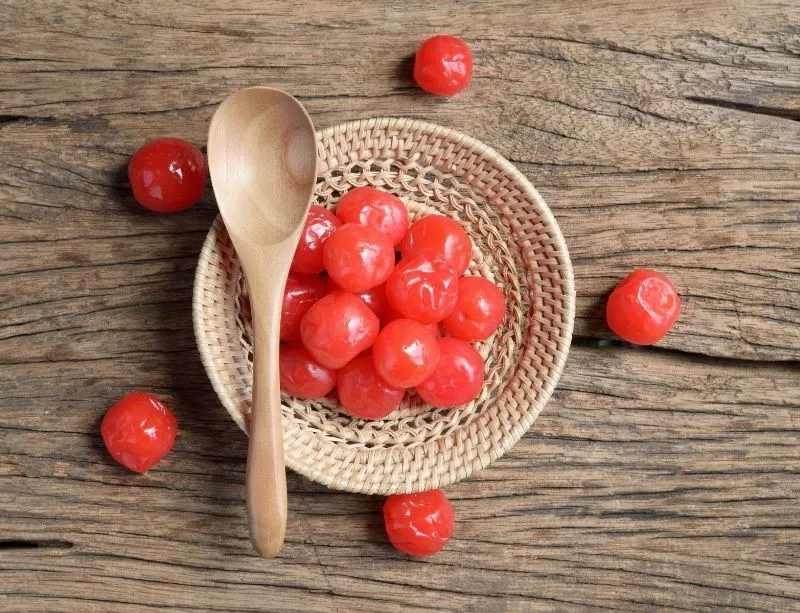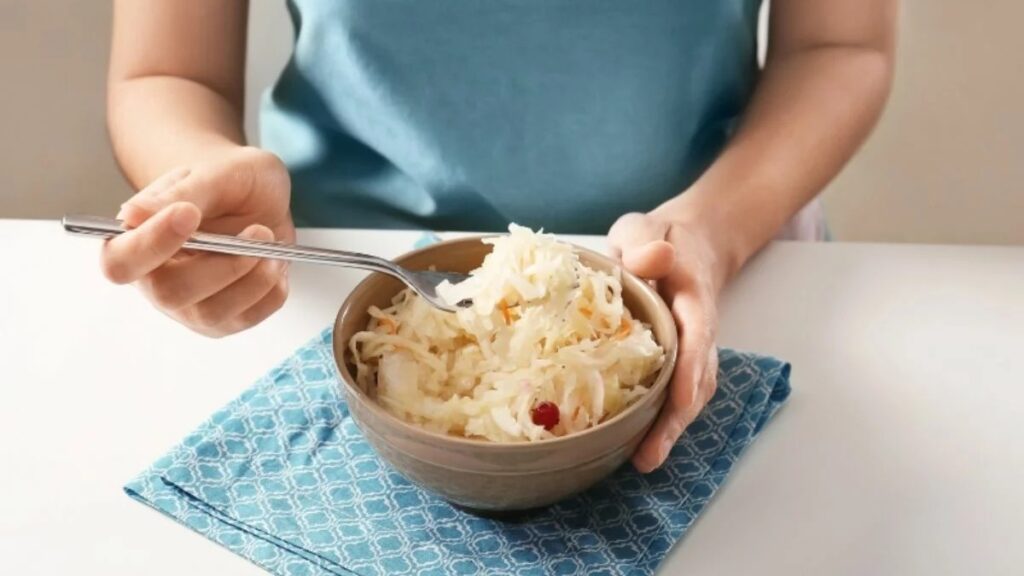Learn how to preserve fruit through lacto-fermentation!
Lacto-fermentation is a preservation technique based on salt and lactic acid bacteria. In this process, bacteria eat the sugar contained in food and produce lactic acid.
The most common lacto-fermentations are those made from vegetables, such as sauerkraut, pickles, or kimchi. However, any fruit and vegetable can also be processed.
This article will explain the fundamentals of fermenting any fruit.
Please note there are several types of fermentation for processing fruit. This article will NOT cover alcoholic fermentation (cider, mead, wine), acetic fermentation (vinegar), or mixed fermentation (kefir, kombucha, etc.)
Go straight to the section that interests you:
- Why ferment fruit?
- Basic principles for fruit fermentation
- Recipe for lacto-fermented plums
- Tips for successfully fermenting fruit
- How to eat lacto-fermented fruit
Why Ferment Fruit?
Lacto-fermentation has many advantages for preserving fruit. First of all, it is extremely safe and easy to do at home.
In addition, lacto-fermentation has many benefits: fermented foods are packed with good probiotics and retain their nutrients through fermentation.
However, a particular advantage of lacto-fermented fruit is the new sour, salty, and umami flavour they develop during fermentation.
In addition, the aromas and flavours of lacto-fermented fruit are still present, allowing you to rediscover a common fruit in an entirely new way. Sweet and savoury lovers, you are in for a treat!
Fermented Fruit Examples
Any fruit can be lacto-fermented, but some produce better results than others.
Lacto-fermented plums are typical of Asian cultures. Also known as umeboshi plums, they are used to season rice and various dishes. Most stone fruit (peaches, cherries, apricots, etc.) are very suitable for fermentation.
Citrus fruit also work well: lemons, limes, and oranges are among our favourites. After fermentation, you can even eat the peel and use it in recipes! Lacto-fermented lemons, also known as salt-preserved lemons, are a must in North African cuisine.
Berries (blueberries, blackberries, gooseberries, etc.) are also excellent choices. They can be used as a sweet and sour condiment and are absolutely delicious on ice cream or fresh cheese.
Mixing Fermented Fruit and Vegetables
To tame the taste of lacto-fermented fruit, add it to a vegetable fermentation! Fruit give the mixture a sweet and aromatic touch.
For example, our (absolutely delicious) recipe for orange lacto-fermented carrots uses a slice of orange to add flavour to the carrots.
Apples and pears are often used to counterbalance the spiciness and saltiness of kimchi or sauerkraut recipes. Adding fruit to vegetable fermentations is a great way to tame the taste.
Mango and pineapple create magic when added to chilies and other herbs in the preparation of hot sauces or salsa.
In addition, fermented fruit make excellent condiments! Try a mango chutney, fruit ketchup, or fermented cranberry chutney!
How to Lacto-Ferment Fruit
The basic principles for fermenting fruit are the same as for fermenting vegetables:
- Mix the fruit with salt.
- Put in a jar.
- Let them ferment for a few days at room temperature.
- Refrigerate.
However, as fruit are more delicate, we do not recommend blending the fruit with salt, as this will result in a mush. The simplest solution is to use brine to submerge the fruit.

Alternatively, fruit can be left to soak in salt so that they are quickly submerged in the brine. We recommend using a heavier weight to push the fruit under the brine.
Vacuum fermentation is an interesting solution to avoid damaging the fruit, but it is not essential to the success of your fermentation.
For more information, see our Complete Guide to Lacto-Fermentation.

Recipe for Lacto-Fermented Plums
Equipment
- Large bowl
Ingredients
- 400 g plums or enough to fill the jar
- 10 g salt
- lactic acid bacteria culture
- water
Steps
- Cut the plums into quarters and remove the stones (optional).
- Thoroughly mix the plums and salt in the bowl.
- Allow soaking for 30 minutes.
- Transfer the plums to the jar and add the lactic acid bacteria source. Place the ViscoDisc and, if necessary, add water to cover it.
- Close the lid.
- Let it ferment for a week if you want a sweet and sour taste, or up to a month if you are looking for tangy flavours.
- Remove the counterweight and refrigerate.
Notes
- 1 bag of commercial lactic acid bacteria
- 1 tbsp. of brine from a previous fermentation
- 1 tbsp. of whey
Tips for Successful Fruit Fermentation
While the basic principles of lacto-fermentation apply to both fruit and vegetables, there are a few tips that can help you succeed with your fruit fermentations.
1. Choose the right fruit
Fruit should be fresh and firm if you want to eat them firm.
If they are too ripe, they will fall apart during fermentation. However, very ripe fruit can be used, for example, to make a sauce.
2. Put enough salt
Fruit is rich in sugar, which many micro-organisms love. To prevent yeast from attacking your fruit, make sure you add salt, equivalent to 2% of the weight of the fruit.
For more information, see our Complete Guide on Salt and Brine in Fermentation.
3. Add a source of lactic acid bacteria
Adding a source of lactic acid bacteria will guide the fermentation and maximize its chances of success.
Add a culture of lactic acid bacteria, some brine from a previous lacto-fermentation, or whey.
4. Testing different fermentation times
To discover all that lacto-fermented fruit have to offer, experiment with different fermentation times. For sweet and savoury results, stop the fermentation at one week (or less!)
On the contrary, if you are looking for more umami and tangy flavours, let it ferment for several weeks to give the bacteria a chance to consume all the sugar in the fruit. All that will be left is their aroma!
How to Eat Lacto-Fermented Fruit
Although we’re not really used to eating lacto-fermented fruit, they fit absolutely everywhere! Try them as condiments, or to add unusual flavours to a marinade or dressing.
Here are some suggestions:
- Fermented lemons in chicken dishes
- Fermented peaches and nuts on pizza
- Fermented sour cherries as an aperitif (like olives!)
- Blueberries (and their brine!) on vanilla ice cream
- Umeboshi plums to season rice
- Fermented pears in a salad
- Fermented fruit brine in vinaigrette


